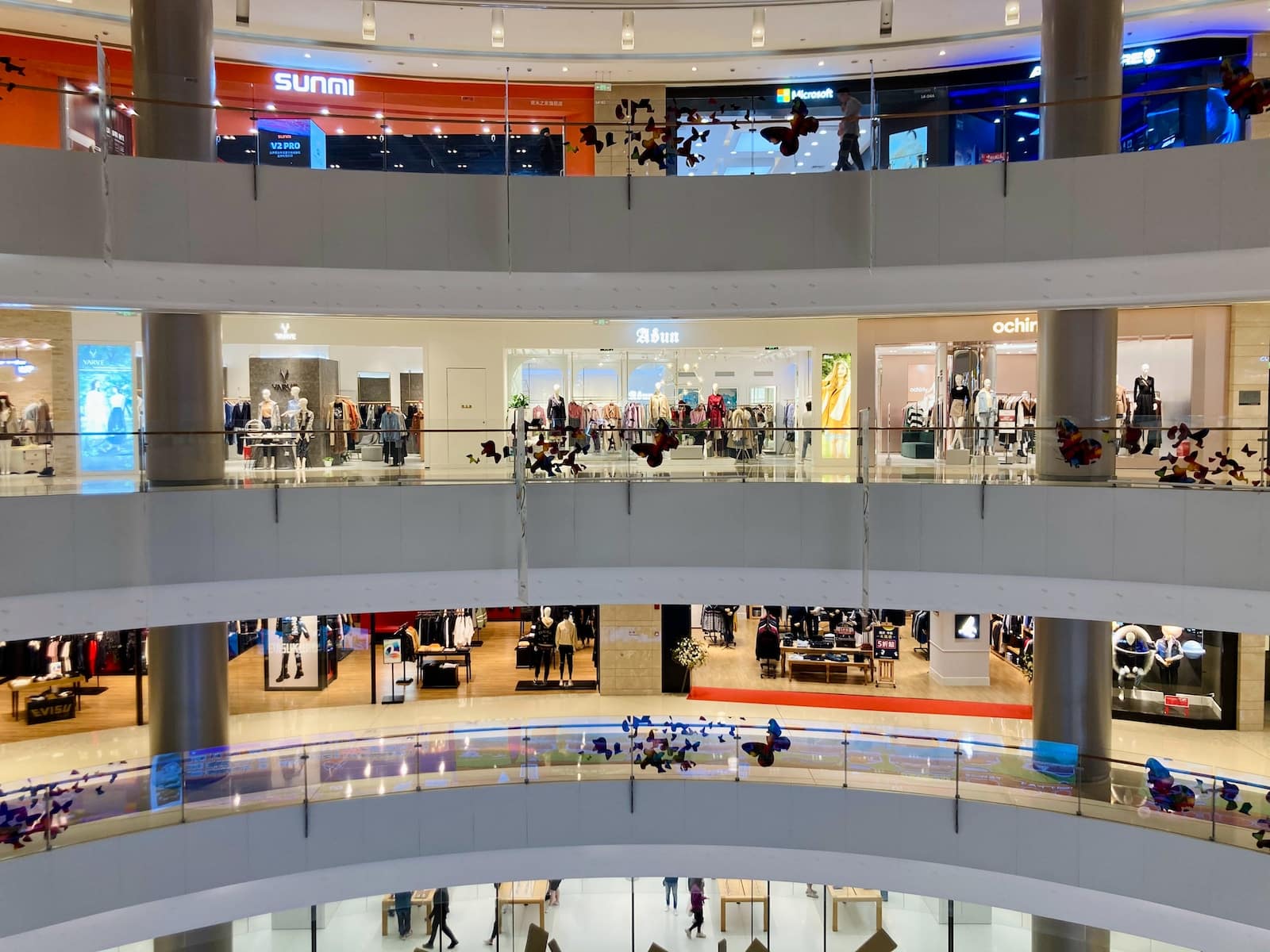The evolution of shopping malls in the digital era

Shopping malls have long been a staple in our everyday lives. In the past few decades, they’ve transformed from mere retail focused hubs into multi-purpose destinations offering a range of services like dining, entertainment, and even fitness facilities. However, with the rise of online shopping and the digital revolution, the retail landscape has dramatically shifted. This evolution is reshaping the traditional mall experience, pushing retailers to adapt and innovate to keep pace with the changing consumer demands.
The Impact of Online Shopping on Traditional Malls
As the internet has become more prevalent in our lives, so too has the trend of online shopping. The convenience of being able to shop from anywhere at any time has led to a surge in popularity for online retailers, changing the way people shop and putting pressure on traditional brick-and-mortar stores.
Dans le meme genre : Creating a real estate business plan that works
The shift to online shopping has been accelerated by the global health crisis. With lockdowns and social distancing measures imposed, consumers have turned to online platforms for their shopping needs. This trend is expected to continue even after the pandemic, as consumers get more accustomed to the convenience and safety of shopping from home.
The rise of e-commerce giants such as Amazon and Alibaba has also disrupted the traditional retail industry. They offer a wide range of products at competitive prices, often with the added benefit of same-day or next-day delivery. This has forced many physical retailers to rethink their strategies and explore digital avenues to stay relevant.
Cela peut vous intéresser : The changing face of real estate post-covid
The Role of Technology in Revamping the Mall Experience
In response to the challenges brought about by the digital revolution, many shopping malls and retailers are turning to technology to enhance the customer experience. They are leveraging various digital tools and technologies to attract consumers back to their physical stores and compete with online retailers.
Augmented reality (AR) and virtual reality (VR) are being used to create immersive shopping experiences. Consumers can virtually try on clothes or accessories, visualize furniture in their homes, or even experience a full virtual store tour from the comfort of their homes. These technologies not only make shopping more interactive and enjoyable but also help consumers make more informed purchasing decisions.
Mobile apps and digital loyalty programs are other key technologies being adopted by retailers. These apps offer personalized deals and reward points, enticing customers to shop more. They also allow retailers to gather valuable data on customers’ shopping behavior, enabling them to tailor their offerings to meet consumer demands.
The Shift towards Experiential Retail
As malls continue to face stiff competition from online shopping platforms, they are focusing more on providing a unique, experiential retail environment that cannot be replicated online. This shift is driven by the realization that shopping is no longer just about the transaction but also about the overall experience.
In an effort to attract and retain customers, shopping malls are introducing a variety of leisure and entertainment options. These range from movie theaters and bowling alleys to gourmet dining and even indoor theme parks. By offering a diverse range of activities, malls aim to become a one-stop destination for recreation and not just shopping.
Retailers, too, are embracing the concept of experiential retail. Stores are being redesigned to provide an interactive, immersive shopping experience. This includes everything from hosting in-store events and workshops, to offering personalized styling advice and product customization services. The goal is to create memorable experiences that foster a deeper connection between the brand and the consumer, and ultimately, drive sales.
The Future of Shopping Malls
Despite the challenges faced, shopping malls are not going extinct. Rather, they are evolving and adapting to keep pace with the changing retail landscape. The future of malls lies in their ability to integrate online and offline shopping experiences, creating a seamless and convenient consumer journey.
Many malls are already embracing the concept of omnichannel retail, where customers can interact with the brand across multiple channels – in-store, online, or through mobile apps. This approach allows consumers to shop and engage with the brand in a way that suits their preferences and lifestyles.
In addition, malls are expected to further leverage advanced technologies like AI and big data to enhance customer experience. This could include personalized recommendations based on consumer behavior, or even predictive shopping, where the system can anticipate what a customer might want or need.
Ultimately, the successful mall of the future will be a blend of retail, technology, and experiential offerings. It will offer a holistic, consumer-centric experience that goes beyond just shopping, making it a vibrant, essential part of people’s lives.
The Changing Role of Real Estate in Shopping Center Architecture
The shift towards experiential retail has also changed the way shopping centers are designed and developed. Real estate developers are now thinking beyond the traditional brick and mortar stores, focusing on creating a holistic and immersive shopping environment that caters to the changing consumer preferences.
In the past, shopping malls were often built with a primary focus on the retail stores. However, with the advent of online shopping, the role of real estate in shopping centers has evolved. Today, the architecture and design of malls are as important as the mix of stores they house. A well-designed mall can enhance the overall shopping experience, making it more enjoyable and memorable for consumers.
One trend that is gaining traction in the mall architecture is the concept of "open-air" or "lifestyle" centers. These are outdoor malls that combine retail, dining, and entertainment in a pedestrian-friendly setting. They are designed to mimic the feel of a traditional downtown or neighborhood, providing a sense of community and a more relaxed shopping environment.
Furthermore, many malls are incorporating sustainable and green design elements, in response to the growing consumer awareness about environmental issues. This includes energy-efficient lighting, water conservation systems, and the use of recycled or sustainable materials in construction.
The layout of malls is also undergoing a transformation. Instead of the traditional anchor store model, where a large department store serves as the main attraction, malls are now focusing on a mix of small and medium-sized stores, boutiques, and experiential spaces. This not only diversifies the retail offerings but also increases foot traffic, as consumers are more likely to explore different stores.
The Role of Financial Services in the Future Shopping Experience
Another emerging trend in the evolution of shopping malls is the integration of financial services. As consumers increasingly seek convenience in their shopping experience, the integration of financial services within retail spaces is becoming more common.
For instance, many shopping centers now house bank branches, ATMs, and even financial advisory services. This not only adds to the convenience factor but also increases foot traffic, as consumers visit the mall for both shopping and banking needs.
Moreover, many retailers are leveraging financial technology (FinTech) to enhance the customer experience. This includes the use of mobile payment apps, digital wallets, and contactless payments, making the payment process faster and more seamless. Some retailers are even experimenting with checkout-free shopping, where consumers can simply walk out of the store with their items, with the payment automatically deducted from their digital wallet.
In addition, retailers are offering a range of financial services to enhance customer loyalty. This includes store credit cards, loyalty programs with cashback or reward points, and even buy-now-pay-later options. These services not only incentivize consumers to shop more but also help retailers gather valuable data on consumer spending patterns.
Conclusion
As the digital era continues to redefine the retail landscape, shopping malls are no longer just a place for commerce but a multi-functional destination that caters to a variety of consumer needs. They are continuously evolving and adapting, leveraging technology and experiential retail to enhance the shopping experience and stay relevant.
The future of shopping centers lies in their ability to combine the convenience of online shopping with the immersive experience of physical retail. They need to provide a seamless, omnichannel shopping journey that caters to the changing consumer preferences. Furthermore, the integration of financial services and the transformation of real estate and architecture in malls are also shaping the future of the mall experience.
Ultimately, the successful mall of the future will not just be a shopping center, but a lifestyle destination that offers a unique blend of retail, leisure, technology, and financial services. It will be a place where consumers can shop, dine, entertain, exercise, and even manage their finances, making it an essential part of their lives.
